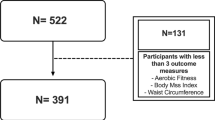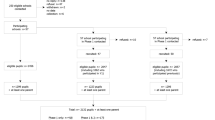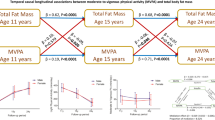Abstract
OBJECTIVE:
To determine the levels and patterns of physical activity in a sample of obese (≥99th percentile body mass index (BMI)) and nonobese (<99th percentile BMI) children.
DESIGN:
Cross-sectional study.
SETTING:
Children were recruited from schools in Bristol and from the childhood obesity clinic, Bristol Royal Hospital for Children. Children were instructed in the use of the accelerometer either while at school or in the clinic, and wore the instrument while carrying out their normal daily activities for 7 days.
PARTICIPANTS:
A total of133 children (mean age 10.5±0.8 y). In all 11 (16.9%) of the 65 girls and 14 (20.6%) of the 68 boys were classified as obese (above the 99th percentile for BMI and corresponding to projected adult BMI of 30).
MAIN OUTCOME MEASURES:
Objectively measured physical activity volume, intensity and pattern.
RESULTS:
Obese children were significantly less physically active overall than their nonobese counterparts (31 844±13 200 vs 41 844±10 430 counts/h; 95% confidence interval 4407 to 15592; P=0.001). Similarly the obese children spent less time in physical activity of moderate or greater intensity than the nonobese children (9.9±3.9 vs 12.9±4.2 min/h; 95% confidence interval 1.15 to 4.80; P=0.002). Hourly patterns of activity indicated a tendency in obese children to be less active than nonobese children at times when activity was more likely to be determined by free choice, particularly outside of school time.
CONCLUSIONS:
Obese children demonstrated patterns of physical activity that may have contributed to and are likely to sustain their obesity. Minute-by-minute accelerometry is a valuable tool to investigate physical activity patterns in obese children. It can identify periods when intervention to increase activity may be most appropriate and provide an evidence base for specific exercise prescription in primary and secondary care.
SPONSORSHIP:
Health Education Authority, NHS R& D South–West
This is a preview of subscription content, access via your institution
Access options
Subscribe to this journal
Receive 12 print issues and online access
$259.00 per year
only $21.58 per issue
Buy this article
- Purchase on Springer Link
- Instant access to full article PDF
Prices may be subject to local taxes which are calculated during checkout


Similar content being viewed by others
References
Ebbeling CB, Pawlak DB, Ludwig DS . Childhood obesity: public-health crisis, common sense cure. Lancet 2002; 360: 473–482.
Chinn S, Rhona RJ . Prevalence and trends in overweight and obesity in three cross-sectional studies of British children, 1974–94. BMJ 2001; 322: 24–26.
Flegal KM, Troiano RP . Changes in distribution of body mass index of adults and children in the US population. Int J Obes Relat Metab Disord 2000; 24: 807–818.
Fagot-Campagna A, Pettit DJ, Engelgau MM, Burrows NR, Geiss LS, Valdez R, Beckles GL, Saaddine J, Gregg EW, Williamson DF, Narayan KM . Type 2 diabetes among North American children and adolescents: an epidemiologic review and a public health perspective. J Pediatr 2000; 136: 664–672.
Drake AJ, Smith A, Betts PR, Crowne EC, Shield JP . Type 2 diabetes in obese white children. Arch Dis Child 2002; 86: 207–208.
Prentice AM, Jebb SA . Obesity in Britain—Gluttony or sloth. BMJ 1995; 311: 437–439.
Davies PSW, Gregory J, White A . Physical activity and body fatness in pre-school children. Int J Obes Relat Metab Disord 1995; 19: 6–10.
Maffeis C, Zaffanello M, Schutz Y . Relationship between physical inactivity and adiposity in prepubertal boys. J Pediatr 1997; 131: 288–292.
Dionne I, Almeras N, Bouchard B, Tremblay A . The association between vigorous physical activities and fat deposition in male adolescents. Med Sci Sports Exerc 2000; 32: 392–395.
Welk GJ, Corbin CB, Dale D . Measurement issues in the assessment of physical activity in children. Res Q Exerc Sport 2000; 71: S59–S73.
Treuth MS, Figueroa-Colon R, Hunter GR, Weinsier RL, Butte NF, Goran MI . Energy expenditure and physical fitness in overweight vs non-overweight prepubertal girls. Int J Obes Relat Metab Disord 1998; 22: 440–447.
DeLany JP, Harsha DW, Kime J, Kumler J, Melacon L, Bray GA . Energy expenditure in lean and obese prepubertal childrenet. Obes Res 1995; 3: 67–72.
Bandini LG, Schoeller DA, Dietz WH . Energy expenditure in obese and nonobese adolescents. Pediatr Res 1990; 27: 198–203.
Ekelund U, Aman J, Yngve A, Renman C, Westerterp K, Sjostrom M . Physical activity but not energy expenditure is reduced in obese adolescents: a case-control study. Am J Clin Nutr 2002; 76: 935–941.
Cooper AR, Page A, Fox KR, Misson J . Physical activity patterns in normal, overweight and obese individuals using minute-by-minute accelerometry. Eur J Clin Nutr 2000; 54: 887–894.
Trost SG, Kerr LM, Ward DS, Pate . Physical activity and determinants of physical activity in obese and non-obese children. Int J Obes Relat Metab Disord 2001; 25: 822–829.
Cole T, Bellizzi M, Flegal KM . Establishing a standard definition for child overweight and obesity worldwide: an international survey. BMJ 2000; 320: 1–6.
Ekelund U, Sjostrom M, Yngve A, Poortvliet E, Nilsson A, Froberg K, Wedderkopp N, Westerterp K . Physical activity assessed by activity monitor and doubly labeled water in children. Med Sci Exerc Sports 2001; 33: 275–281.
Trost SG, Ward DS, Moorehead SM, Watson PD, Riner W, Burke JR . Validity of the computer and science applications (CSA) activity monitor in children. Med Sci Exerc Sports 1998; 30: 629–633.
Epstein LH, Valoski A, Wing RR, McCurley J . Ten-year outcomes of behavioural family-based treatment for childhood obesity. Health Psychol 1994; 13: 373–383.
Ainsworth BE, Haskell WL, Whitt MC, Irwin ML, Swartz AM, Strath SJ, O'Brien WL, Bassett Jr Dr, Schmitz KH, Emplaincourt PO, Jacobs Jr Dr, Leon AS . Compendium of physical activities: An update of activity codes and Met intensities. Med Sci Exerc Sports 2000; 32: S498–S504.
Montgomery C, Reilly JJ, Jackson DM, Kelly LA, Slater C, Paton JY, Grant S . Relation between physical activity and energy expenditure in a representative sample of young children. Am J Clin Nutr 2004; 80: 591–596.
Saris WH, Blair SN, van Baak MA, Eaton SB, Davies PS, Di Pietro L, Fogelholm M, Rissanen A, Schoeller D, Swinburn B, Tremblay A, Westerterp KR, Wyatt H . How much physical activity is enough to prevent unhealthy weight gain? Outcome of the IASO 1st Stock Conference and consensus statement. Obes Rev 2003; 4: 101–114.
Acknowledgements
Contributions: AS Page: Study originator and director, interpretation of data, preparation of manuscript; AR Cooper, Study originator and director, analysis and interpretation of data, preparation of manuscript; E Stamatakis: Data collection and interpretation, preparation of manuscript; LJ Foster: Data collection and interpretation, preparation of manuscript; JPH Shield and E Crowne: Established and run the obesity clinic at Bristol Royal Hospital for Children; M Sabin: Clinical co-ordinator and physician to the follow up clinic.
Author information
Authors and Affiliations
Corresponding author
Rights and permissions
About this article
Cite this article
Page, A., Cooper, A., Stamatakis, E. et al. Physical activity patterns in nonobese and obese children assessed using minute-by-minute accelerometry. Int J Obes 29, 1070–1076 (2005). https://doi.org/10.1038/sj.ijo.0802993
Received:
Revised:
Accepted:
Published:
Issue Date:
DOI: https://doi.org/10.1038/sj.ijo.0802993
Keywords
This article is cited by
-
A Longitudinal Examination of Withholding All or Part of School Recess on Children’s Physical Activity and Sedentary Behavior: Evidence from a Natural Experiment
Early Childhood Education Journal (2023)
-
Physical activity in early childhood: a five-year longitudinal analysis of patterns and correlates
International Journal of Behavioral Nutrition and Physical Activity (2022)
-
Weight status and meeting the physical activity, sleep, and screen-time guidelines among Texas children: results from a population based, cross-sectional analysis
BMC Pediatrics (2022)
-
Effects of Movement Behaviors on Overall Health and Appetite Control: Current Evidence and Perspectives in Children and Adolescents
Current Obesity Reports (2022)
-
Objectively measured physical activity and sedentary time in children with overweight, obesity and morbid obesity: a cross-sectional analysis
BMC Public Health (2021)



